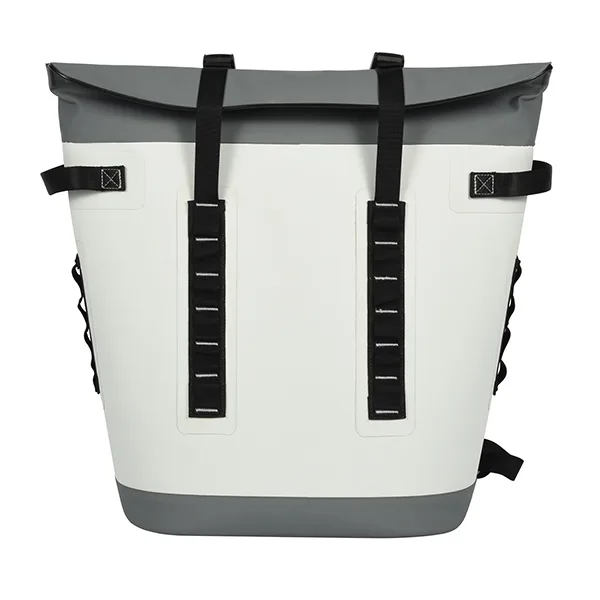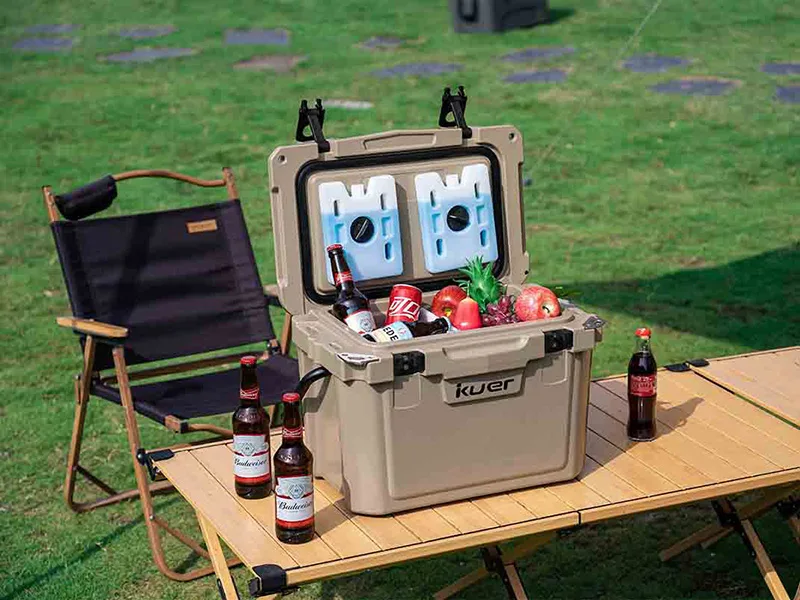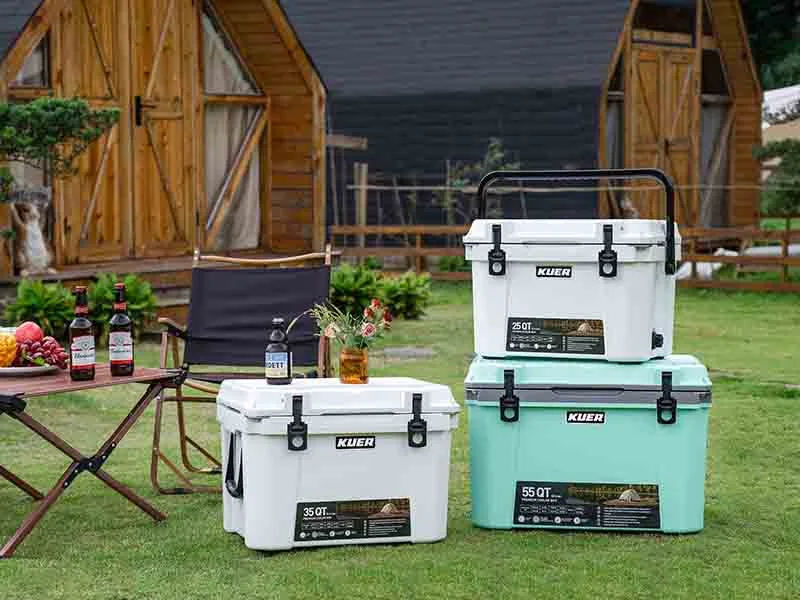

Keeping your food and drinks cold during outdoor adventures doesn’t have to be a hassle. With plastic ice box ice packs, you get a cooling solution that’s not only easy to use but also long-lasting. These packs are designed to maintain low temperatures for extended periods, thanks to advancements in cooling gels and phase-change materials. For example, some reusable ice packs, like the Cooler Shock and Kona Large Ice Packs, can keep items chilled for up to 48 hours. That’s effective cooling you can count on! Whether you’re planning a picnic or a camping trip, mastering these outdoor ice chest cooler ice packs ensures an easy and efficient way to enjoy long-lasting cooling.
Kuer, one of the leading cooler box manufacturers will provide you with a variety of cooler solutions.
Preparing Cooler Box Ice Packs for Use

Pre-chilling the cooler for optimal performance
If you want your cooler to perform at its best, pre-chilling is a must. Think of it as giving your cooler a head start before the real work begins. When you pre-chill the cooler, you lower its internal temperature, so it doesn’t absorb the cooling energy from your ice packs. This simple step can make a big difference in how long your items stay cold.
To pre-chill the cooler, place ice packs or frozen water bottles inside it for about an hour before packing. This helps create a cold environment right from the start. Studies show that pre-cooling systems like the EC pad are highly effective in reducing temperature variations. For example:
| Pre-Cooling System | Average Effectiveness | Maximum Effectiveness |
|---|---|---|
| EC Pad | 0.55 | 0.63 |
| Mist Cooling | 0.43 | 0.48 |
| EC Pad + Mist Cooling | 0.49 | 0.58 |
Among these, the EC pad system stands out for maintaining higher performance across a wider range of cooling capacities. By pre-chilling, you’re not just cooling the cooler—you’re setting the stage for maximum efficiency.
Tip: Always pre-chill the cooler before adding your food and drinks. It’s a small step that delivers big results.
Freezing reusable ice packs properly
Reusable ice packs are a game-changer for keeping your cooler cold. But to get the most out of them, you need to freeze them the right way. Start by laying the ice packs flat in your freezer. This ensures even freezing and makes them easier to stack when packing the cooler. Most reusable ice packs need about 24 hours to freeze completely, so plan ahead.
When choosing reusable ice packs, look for ones that are durable and freeze quickly. Gel-based ice packs are a popular choice because they stay colder longer than traditional ice. Hard-shell ice packs, on the other hand, are great for withstanding rough handling. Whichever type you choose, make sure it fits well in your cooler.
Note: Always check the manufacturer’s instructions for freezing times and temperatures. Proper freezing ensures your ice packs deliver maximum cooling power.
Packing a cooler with pre-chilled items
Packing a cooler effectively starts with pre-chilled items. If your food and drinks are already cold, your ice packs won’t have to work as hard to keep them that way. Pre-chill your items by refrigerating or freezing them before packing. This reduces the thermal load on the ice packs, allowing them to stay frozen longer.
Here’s a quick tip: Pre-chill your insulated bag or cooler by placing ice packs inside it for about an hour before packing. This creates a cold base that helps maintain low temperatures throughout your trip. By doing this, you ensure your items stay fresh and delicious for longer.
When packing a cooler, start with a layer of ice packs at the bottom. Then, add your pre-chilled items, followed by another layer of ice packs. This layering technique ensures even cooling and keeps everything at the right temperature.
Pro Tip: Fill any gaps in the cooler with smaller ice packs or frozen items. This minimizes air circulation, which can cause the temperature to rise.
By following these steps, you’ll master the art of packing a cooler and enjoy longer-lasting cooling for all your adventures.
Strategic Placement of Ice Packs for Coolers
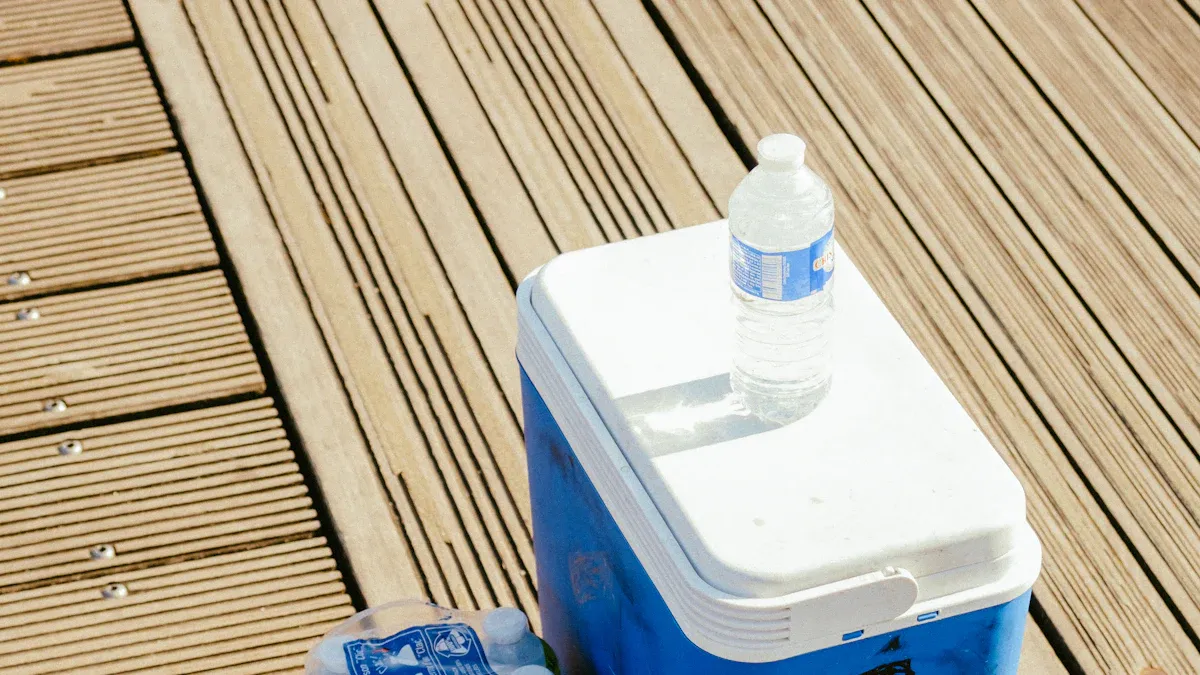
When it comes to keeping your cooler cold for as long as possible, where you place your ice packs matters just as much as how many you use. Strategic placement ensures even cooling and helps maintain low temperatures throughout your trip. Let’s break it down step by step.
Creating a cooling base with ice packs at the bottom
Start by building a solid cooling foundation. Place a layer of ice packs at the bottom of your cooler. This base acts as the primary source of cold air, which naturally rises to chill the items above. By doing this, you ensure that the cold air circulates upward, keeping everything inside cool.
For the best results, use flat or rectangular ice packs that fit snugly at the bottom. This minimizes gaps and prevents warm air from sneaking in. If you’re packing drinks, place them directly on top of this cooling base. Cans and bottles stay colder longer when they’re in direct contact with the ice packs.
Tip: If you’re using a soft-sided cooler, make sure the bottom layer of ice packs is evenly distributed. This prevents uneven cooling and keeps your items fresh.
Layering ice packs in the middle for even cooling
Layering ice packs in the middle of your cooler is a game-changer. This technique creates a cold barrier that helps maintain a uniform temperature throughout. When you add a middle layer of ice packs, you’re essentially dividing the cooler into two cooling zones. This ensures that items at the top and bottom stay equally chilled.
Here’s how layering works in practice:
| Layer Position | Freezing Time Difference |
|---|---|
| Middle Layer | Up to 2 days longer |
| Exterior Layer | Standard freezing time |
As you can see, the middle layer significantly extends the cooling time. This happens because the ice packs in the center reduce temperature fluctuations, keeping the cooler’s interior consistently cold. To maximize this effect, alternate layers of ice packs and pre-chilled items. For example, place a layer of ice packs, then add food or drinks, and repeat.
Pro Tip: Use gel-based ice packs for the middle layer. They stay colder longer and provide steady cooling, making them ideal for this purpose.
Using ice packs on top to trap cold air
Don’t forget the top layer! Placing ice packs on top of your cooler helps trap cold air inside. Cold air is heavier than warm air, so it naturally sinks. By adding ice packs on top, you create a barrier that prevents warm air from entering when you open the lid.
This top layer is especially important if you’re packing perishable items like dairy or meat. It keeps the cold air concentrated where it’s needed most. For added efficiency, use hard-shell ice packs on top. They’re durable and can handle the weight of the lid without losing their shape.
Note: Always close the cooler lid tightly after adding or removing items. This simple habit helps maintain the cold air trapped by the top layer of ice packs.
By following these placement strategies, you’ll get the most out of your ice packs and enjoy longer-lasting cooling. Whether you’re heading to the beach or camping in the woods, a well-packed cooler makes all the difference.
Filling gaps to minimize air circulation
When it comes to keeping your cooler cold for longer, every little detail matters. One often-overlooked trick is filling the gaps inside your cooler. Those empty spaces might seem harmless, but they allow warm air to circulate, which can melt your ice packs faster. By minimizing air circulation, you can lock in the cold and keep your food and drinks fresh for hours—or even days.
So, how do you fill those gaps effectively? Here are some simple and practical tips:
- Use smaller ice packs or frozen items: If you notice gaps between your food and drinks, slide in smaller ice packs or frozen water bottles. These not only fill the space but also add extra cooling power.
- Pack tightly: Arrange your items as snugly as possible. A tightly packed cooler leaves less room for warm air to move around.
- Add soft items like towels or napkins: If you run out of ice packs, use clean towels or napkins to fill the gaps. They won’t cool your items, but they’ll help block airflow and maintain the temperature.
Tip: Always pack your cooler in layers, starting with a solid base of ice packs at the bottom. Then, add your items and fill any remaining gaps as you go. This method ensures even cooling and reduces temperature fluctuations.
Filling gaps isn’t just about keeping things organized—it’s a proven way to enhance cooling efficiency. For example, QTS, a data center company, optimized airflow by sealing gaps around doors and cable holes. This simple step prevented cool air from escaping and stopped warm air from entering. As a result, their cooling system became more efficient, saving energy and improving performance. While your cooler isn’t a data center, the same principle applies. Sealing gaps helps maintain a consistent temperature, giving you longer-lasting cooling.
By taking the time to fill those pesky gaps, you’re not just packing a cooler—you’re creating a mini fortress against the heat. Whether you’re heading to the beach or camping in the woods, this small effort can make a big difference in keeping your items perfectly chilled. So, next time you pack your cooler, remember: no gap is too small to seal!
Choosing the Best Ice Packs for Coolers
Evaluating size, durability, and freezing time
When choosing ice packs for coolers, size, durability, and freezing time are key factors to consider. The right size ensures the ice packs fit snugly in your cooler without wasting space. Compact options like the YETI ICE Packs are designed to fit various cooler sizes while delivering excellent cooling performance. Larger ice packs, such as Arctic Ice Packs, provide extended cooling but may take up more room.
Durability is another critical aspect. Reusable ice packs should withstand repeated use without cracking or leaking. For example, Rubbermaid Blue Ice Packs are known for their reliability and affordability, while SmartIce Gel Packs offer a flexible yet durable design. Always inspect your ice packs for fissures or cracks before each use to avoid leaks.
Freezing time also impacts cooling efficiency. Cooler Shock Ice Packs, for instance, are engineered for high-performance cooling and can be recharged with water. However, tests show that colder freezing temperatures (like 5°F) may not always result in longer cooling times. Instead, a balance between freezing temperature and pack design is essential for effective cooling.
Tip: Choose ice packs that match your cooler’s size and your trip’s duration. Durable and compact options often provide the best balance of convenience and performance.
Comparing gel-based and hard-shell ice packs
Gel-based and hard-shell ice packs each have unique advantages. Gel-based packs, like Arctic Zone Titan Deep Freeze Ice Packs, are flexible and easy to use. They mold around items in your cooler, maximizing contact and cooling power. These packs are ideal for irregularly shaped items or when you need even cooling throughout.
Hard-shell ice packs, on the other hand, are built for durability. They can handle rough handling and heavy loads, making them perfect for outdoor adventures. The YETI ICE Large Refreezable Pack combines a slim design with robust construction, ensuring it fits easily in your cooler while maintaining its shape.
Both types have their strengths, so your choice depends on your needs. If you prioritize flexibility and compact storage, gel-based packs are a great option. For rugged durability and long-lasting cooling, hard-shell packs are the way to go.
Budget-friendly and premium reusable options
Finding the right balance between cost and quality is crucial when selecting reusable ice packs. Budget-friendly options like Rubbermaid Blue Ice Packs offer reliable cooling at an affordable price. These packs are perfect for casual outings or short trips. Similarly, Igloo Extra Large Ice Blocks provide excellent value with their gel-insulated design, lasting up to 24 hours.
Premium reusable ice packs, such as the Pelican 2lb Ice Pack, deliver advanced cooling performance and durability. These high-quality ice packs often feature innovative designs, like freezing at specific temperatures for extended coldness. For environmentally conscious consumers, premium options like the Arctic Ice Tundra Series offer freezer-like conditions with a low freezing point.
| Factor | Budget-Friendly Options | Premium Options |
|---|---|---|
| Material Quality | Often use lower-cost materials | High-quality, durable materials |
| Insulation Technology | Basic insulation methods | Advanced insulation for longer cooling |
| Branding Strategies | Focus on cost-effectiveness | Emphasize brand prestige and quality |
| Consumer Preferences | Price-sensitive consumers | Environmentally conscious and performance-focused consumers |
| Product Versatility | Limited multifunctionality | Often multifunctional (e.g., seats, storage) |
Pro Tip: If you’re looking for an effective cooling solution without breaking the bank, budget-friendly options are great for short-term use. For longer trips or frequent use, investing in premium reusable ice packs ensures better cooling performance and durability.
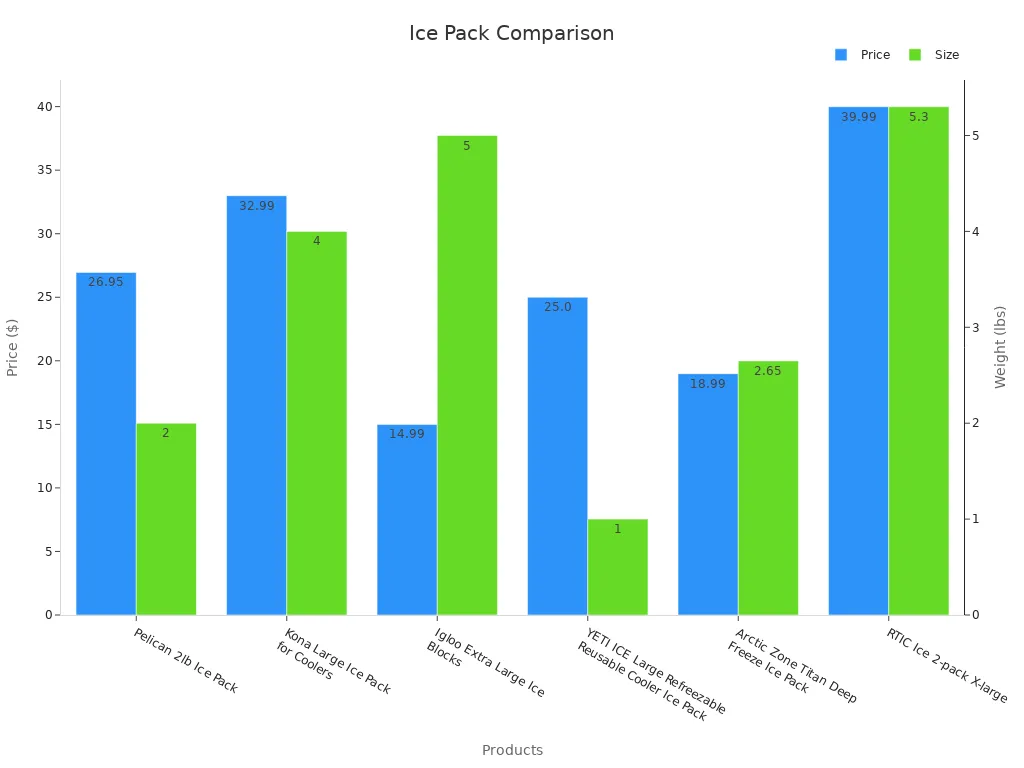
By evaluating your needs and preferences, you can find the perfect ice packs for coolers that balance cost, durability, and cooling power.
Recommended cooler box ice packs for maximum cooling
Choosing the right ice packs for coolers can make or break your outdoor experience. With so many options available, it’s important to pick ones that deliver maximum cooling capacity while being durable enough for repeated use. Here are some top recommendations to help you make the best choice.
-
Cooler Shock Ice Packs
Cooler Shock Ice Packs are a favorite among outdoor enthusiasts. These packs are designed to freeze at 18°F, providing extended cooling capability for up to 48 hours. They’re reusable, durable, and easy to activate with water. Whether you’re camping or tailgating, these packs keep your food and drinks cold for longer. -
YETI ICE Packs
YETI ICE Packs are known for their rugged design and efficient cooling. Their unique shape allows for faster freezing and better cooling performance. These durable packs are perfect for rough outdoor adventures. Plus, they fit snugly in most coolers, maximizing space and cooling efficiency. -
Arctic Ice Tundra Series
If you need freezer-like conditions, the Arctic Ice Tundra Series is a great choice. These ice packs for coolers are engineered to freeze at 5°F, making them ideal for keeping meat and other perishables fresh. They’re durable and built to last, even after years of use. -
Rubbermaid Blue Ice Packs
For a budget-friendly option, Rubbermaid Blue Ice Packs are reliable and effective. They’re lightweight, durable, and provide consistent cooling for shorter trips. These packs are great for picnics or day outings. -
Pelican Ice Packs
Pelican Ice Packs combine durability with extended cooling capability. They’re leak-proof and designed to withstand tough conditions. These packs are perfect for long camping trips or fishing expeditions.
Tip: Always choose ice packs that match your cooler size and trip duration. Durable options ensure you get the most out of your investment.
By selecting the right ice packs, you’ll enjoy fresh food and cold drinks no matter where your adventures take you.
Maintaining Reusable Ice Packs for Longevity
Monitoring cooler temperature during use
Keeping an eye on your cooler’s temperature is key to getting the most out of your reusable ice packs. When the temperature inside rises, your ice packs work harder and thaw faster. To avoid this, try using a thermometer to monitor the internal temperature. Aim to keep it below 40°F, especially if you’re storing perishable items like meat or dairy.
Opening the cooler frequently can let warm air in, which speeds up the thawing process. Instead, plan ahead and grab everything you need in one go. If you’re on a long trip, consider adding refreezable ice packs midway to maintain consistent cooling. This small step can make a big difference in keeping your items fresh.
Tip: Place a thermometer near the top of the cooler for accurate readings. It’s a simple way to ensure your reusable ice packs are doing their job.
Draining excess water to prevent warming
As your ice packs thaw, they may release condensation or water. If this water pools at the bottom of your cooler, it can reduce the overall cooling efficiency. Warm water creates a humid environment, which can speed up the warming process.
To prevent this, drain any excess water regularly. Most coolers come with a built-in drain plug—use it to empty the water without disturbing the contents. If your cooler doesn’t have one, carefully tilt it to pour out the water. Keeping the interior dry helps your reusable ice packs stay colder for longer.
Pro Tip: Add a layer of absorbent material, like a towel, at the bottom of the cooler. It soaks up moisture and keeps the space dry.
Refreezing ice packs after thawing
Reusable ice packs are designed to be refrozen and used again, making them a cost-effective and eco-friendly choice. After your trip, clean the ice packs with warm, soapy water to remove any dirt or bacteria. Once they’re dry, lay them flat in the freezer. This ensures even freezing and prepares them for your next adventure.
Most reusable ice packs need about 24 hours to freeze completely. If you’re short on time, consider using a freezer with a lower temperature setting to speed up the process. Proper refreezing not only extends the life of your ice packs but also ensures they deliver maximum cooling every time you use them.
Note: Always check the manufacturer’s instructions for specific freezing guidelines. Following these ensures your refreezable ice packs stay in top condition.
By monitoring temperatures, draining water, and refreezing properly, you can extend the life of your reusable ice packs. These simple steps help you enjoy reliable cooling for all your outdoor adventures.
Cleaning and storing ice packs properly
Taking care of your reusable ice packs ensures they last longer and perform better. Cleaning and storing them properly is simple, but it makes a big difference. Let’s dive into how you can keep your ice packs in top shape.
Cleaning Your Ice Packs
After every use, clean your reusable ice packs to remove dirt, bacteria, or food residue. Use warm water and mild soap to wash them. A soft sponge works well for scrubbing without damaging the surface. Rinse thoroughly to make sure no soap remains. If your ice packs have a hard shell, check for cracks or leaks while cleaning. Damaged packs can lose their cooling power and may need replacing.
Tip: Dry your ice packs completely before storing them. Moisture can lead to mold or unpleasant odors.
Storing Your Ice Packs
Proper storage keeps your reusable ice packs ready for the next adventure. Lay them flat in your freezer to maintain their shape and ensure even freezing. If you’re short on freezer space, stack them neatly or place them upright. For long-term storage, keep them in a cool, dry place away from direct sunlight. Heat can weaken the materials and reduce their effectiveness.
Here’s a quick checklist for storing ice packs:
- ✅ Dry them completely after cleaning.
- ✅ Store them flat or stacked in the freezer.
- ✅ Avoid exposure to heat or sunlight.
- ✅ Inspect for damage before freezing again.
By following these steps, you’ll extend the life of your reusable ice packs and enjoy reliable cooling every time you use them. Whether you’re heading out for a picnic or a camping trip, well-maintained ice packs make all the difference.
Mastering cooler box ice packs is all about preparation, placement, and care. By pre-chilling your cooler, freezing reusable ice packs properly, and packing strategically, you create a cooling solution that’s both effective and easy to use. Choosing the right ice packs for coolers tailored to your needs ensures long-lasting performance, whether you’re on a short picnic or a multi-day camping trip.
The effectiveness of cooler box ice packs lies in their ability to maintain low temperatures for extended periods. Tests show that some coolers retain ice for over 24 hours, proving their value in outdoor settings. With proper maintenance, reusable ice packs deliver consistent cooling performance, making them a reliable choice for keeping your food and drinks fresh.
By following these tips, you’ll enjoy long-lasting cooling and stress-free adventures. Cooler box ice packs are not just a tool—they’re your ultimate cooling companion for every outdoor journey.
FAQ
How long do reusable ice packs stay cold?
Reusable ice packs typically stay cold for 24 to 48 hours, depending on their size and type. Gel-based packs often last longer than hard-shell ones. For best results, freeze them completely and pack your cooler strategically to maximize their cooling power.
Can I use regular ice with reusable ice packs?
Absolutely! Combining regular ice with reusable ice packs boosts cooling efficiency. Ice packs help maintain a consistent temperature, while regular ice fills gaps and extends cooling time. This combo works great for long trips or when packing perishable items.
Are reusable ice packs safe for food storage?
Yes, reusable ice packs are food-safe when used correctly. Most are made from non-toxic materials. Always check the manufacturer’s label to confirm safety standards. Keep them sealed and avoid direct contact with unpackaged food to prevent contamination.
How do I clean reusable ice packs?
Cleaning reusable ice packs is simple. Use warm water and mild soap to wash them after each use. Dry them completely before storing to prevent mold or odors. Inspect for cracks or leaks during cleaning to ensure they’re ready for reuse.
What’s the best way to store reusable ice packs?
Store reusable ice packs flat in your freezer for even freezing. If freezer space is limited, stack them neatly or place them upright. For long-term storage, keep them in a cool, dry place away from sunlight to preserve their durability.

